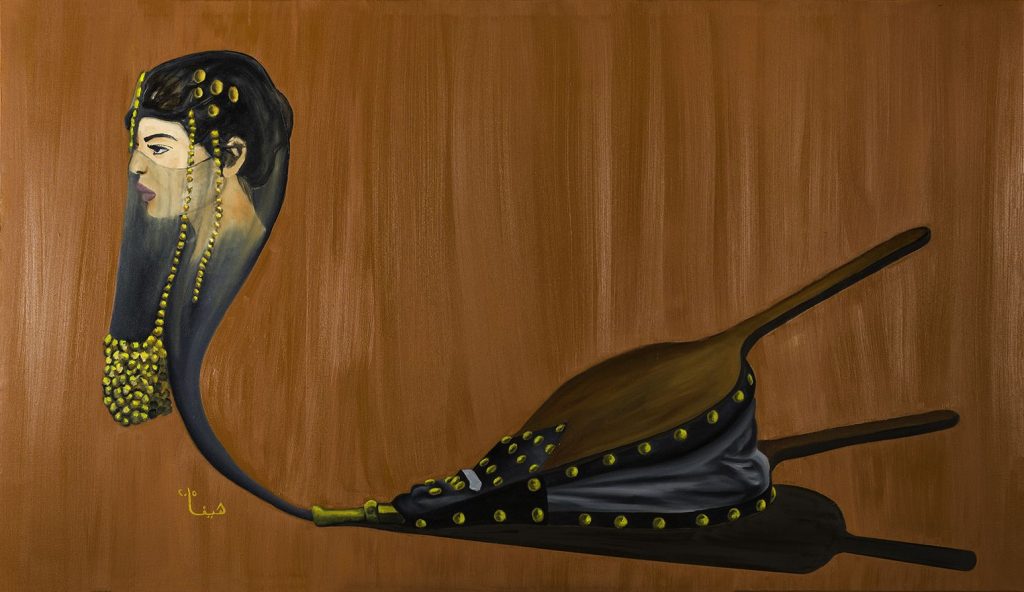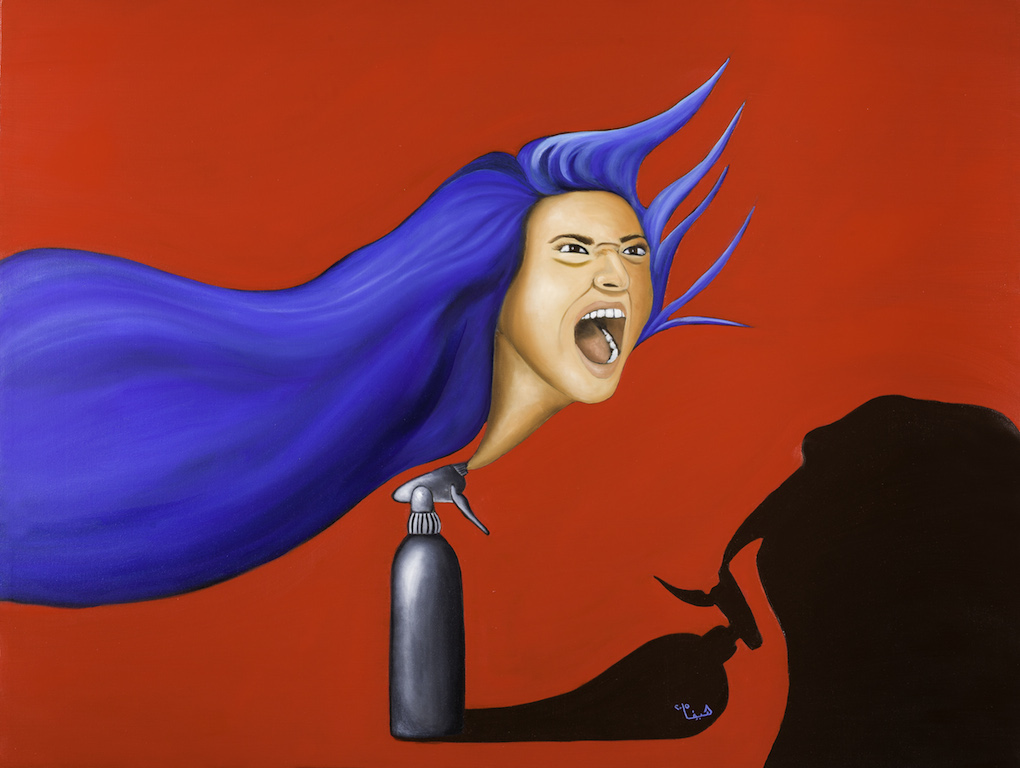Was there a defining moment when you knew you wanted to be an artist?
I will never forget the first time that [Saudi painter] Mona Al-Qasabi mixed colours in front of me. I was 19. Prior to this I had never had a real purpose. I remember sitting in school and putting charcoal down on white paper: it meant nothing to me. But then Mona came into my life. She started mixing colours in front of me, and I can’t explain it…I awoke! The richness and vivacity of the oils touched something very deep in my spirit; I was hooked. I knew almost immediately that this was what I wanted to do with my life.
Why are you attuned to surrealist art in particular?
At the end of the first course I took with Mona Al-Qasabi, we were asked to paint in any style we wanted. I couldn’t help but be drawn towards surrealist representation. I painted a woman who was arising out of flames and smoke. At the time, I did not think of myself as a surrealist painter, but in retrospect it was clear that this is where my intention was leaning.
Which artist has had a big influence on you?
Dalí has been a major influence for me. I love his powerful narratives and the way that he integrates objects and ideas that seemingly have nothing to do with each other, but tell an intriguing and rich story. I did not know this at the time, but now I know that surrealists such as Frida Kahlo and Salvador Dalí were strongly influenced by psychoanalytic thinkers, who first began to shed light on the power and influence of the unconscious.

Any contemporary artists?
I have been greatly influenced by more contemporary painters such as Vladimir Kush (with whom I had the fortune of studying). True to the surrealist style, I attempt to paint in a stream of consciousness style that brings together and utilises many seemingly disparate symbols of the unconscious in an attempt to tell a unified story.
What does your creative process look like?
I’ve never excelled at realism and observation. I can do it, and I’ve certainly had training in it through the Academy of Art University [in San Francisco], but my true form of painting stems from the imagination. For my most recent series, I asked myself, ‘what objects can I integrate with human forms in an unexpected and intriguing way?’ From this initial question I began to envision ice cubes, perfume bottles, hookahs, ice cream cones, light bulbs and other common items that I could use to interact with the human form in interesting ways. My artwork is bold, uses vibrant colours, and taps into the unspeakable imagination.
Why were you drawn to those items?
I have reasons for the objects and representations I’ve created, but I choose never to tell the viewer what I want her to experience or feel through my work. I believe that true art should be capable of creating its own feeling in the viewer, and it may often be quite different from what I intend. True art is not linear or predictable.

You talk about your brush setting you free, tell us more about that.
For me, being an artist means being myself. In the world we live in, there are so many pressures placed on us to conform, to be traditional, to do what everybody else does or to speak and act as “we should”. But the art and the artist cannot be tamed and must not buckle to conformity. The artist is the true voice: The self-expressed in relation to the world. And for me, my truest expression comes through my brush.
Your work often reflects aspects of life in Saudi Arabia - how do you address the position of women in particular?
In the art world and in general, women often gain less visibility and recognition than men. But the female voice is becoming louder in the Kingdom and within the Gulf region. This is undeniable. Last year I was asked to participate in an exhibition honouring the work of Saudi women (Cube Art in Dubai). There have been many similar exhibitions in the past few years, as the role of the woman is expanding in the Kingdom. Women are taking on more prominent professional identities in Saudi like doctors, lawyers, professors, etc.
How has that affected you personally?
I have always believed myself to be a strong, focused, and powerful human being, and so I use my art to identify and present these strong views to the public. There’s no question that I feel this shift. Several of my close friends (Malak Tabsh, Etab Al Shaikh, Mona Al-Qasabi, Fatma Omran) are female artists, and the new trend has opened doors for us and created both opportunity and inspiration.

Do you feel like a spokesperson for Saudi women in the creative field?
I don’t see myself as a spokesperson. My art takes a lot from my culture, because that’s the environment that I grew up in; but it's just a representation of myself.
What does it mean to you to have a solo exhibition at Stellan Holm gallery in New York?
It is amazing to me that I have a solo show in New York – it is certainly a dream come true. Stellan Holm is a much known gallery in Manhattan and the idea that my work will be featured in this location is both humbling and inspiring to me. I feel blessed.
Profits from the exhibition go to The Child Mind Institute, tell us more about the importance of philanthropy to you.
The Child Mind Institute does an incredible job researching and looking to better the lives of children with ADHD and other mental health disorders. I have been so fortunate in my life to come from an established and stable family, but no one in this world is impervious to hardship, as my middle child was diagnosed with ADHD. Throughout my own childhood, my parents always emphasised the importance and value of giving to others and providing for the needy – especially children. In addition to the Child Mind Institute, I also support the National Home Healthcare Foundation, which my mother ran for many years.
Who has been the biggest supporter of your art?
My husband, Abdulaziz. I don’t know how to possibly thank him for believing in me and pushing me to follow my dream. When he realised how passionate I felt about art, he helped to find me teachers who could bring out my abilities and help me to refine my talents. He is a uniquely supportive and caring husband and friend.
April 21–May 27, 2016, Stellan Holm Gallery 1018 Madison Avenue New York, NY 10075, +1 212 627 7444, Monday to Friday, 10am–6pm





